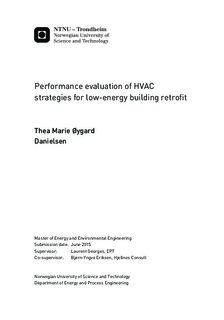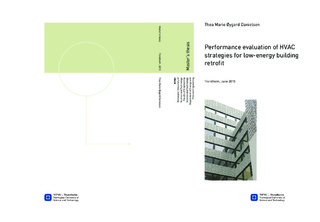| dc.description.abstract | The work in this thesis is done to evaluate four different questions. A literature survey in addition to three case studies are first used to determine the challenges of HVAC systems in buildings renovated to low-energy buildings and the development trend in the market. The literature and case studies showed that client expectations and budget, policies and regulations, everything working as a whole, and a high level of occupant control were all challenges and important factors affecting the success of a construction project. The three case studies had various systems installed, including ground source heat pumps, air-to-water heat pumps, heat recovery in air handling units and solar screens to name a few. The choice of these, however, depended on the building characteristics and its environment.
The second part of the thesis evaluates firstly whether the HVAC systems in a school building, Stasjonsfjellet Skole, is able to achieve a satisfactory indoor climate, as well as whether the focus on reducing the energy use in the building has an adverse effect on the indoor climate. Through IDA ICE simulations of the building, in addition to a user survey, the HVAC systems were concluded to provide a somewhat sufficiently satisfactory indoor climate in the parts of the building, but not for every zone. Some of the zones had very high temperatures, daylighting levels and PPD levels. Furthermore, the users complained that the temperature in the building in general was too low. Although this was not consistent with temperature results from IDA ICE, the simulations showed a low RH level in the colder months of the year, which may cause discomfort for occupants even at moderate temperatures (Novakovic, et al., 2007). Furthermore, the generalization of the standards and regulations was concluded to result in the building having variable indoor climate levels from room to room, indicating that the generalized values are not adapted for the different requirements of the different rooms.
I addition to the conclusions the indoor climate is not completely satisfactory in the building, the focus on reducing the energy use was concluded to have an adverse effect on the indoor temperature. Although there had been improvements to the indoor environment in the building, the lack of cooling caused the building to be too warm in the summer months. Also, given that the temperature was too low for the users due to the low RH levels and varying between the zones, showed that demand control of the HVAC systems to save energy may have an adverse effect on the user comfort.
Lastly, the results and conclusions from the different case studies were evaluated as to whether they could be extended to other buildings. Although all buildings are different, similar school buildings may show similar results when the same systems are installed. Furthermore, the results and conclusions concerning the office buildings may be applied to other buildings as they are highly general. Although the solutions chosen will vary from building to building, the expectations and budget of the client, standards and regulations, optimally interacting systems and a high level of occupant control will all be difficulties and important factors for any construction project, whether it is a retrofitted or new one. Also, the conclusions concerning the generalization of standards and regulations and a need for shading and cooling, although dependent on building characteristics, will be applicable to any building. | |

